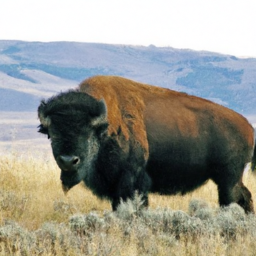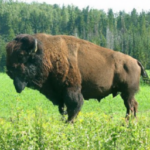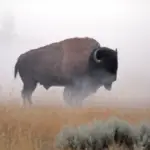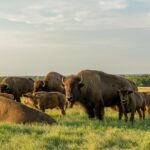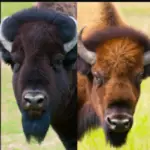Current Bison Population in America
Recent Surveys and Estimates
According to recent surveys and estimates, the current bison population in America stands at approximately 500,000 individuals. While this represents a significant increase from the precarious numbers of the past, it is important to note that it is still a fraction of what it once was. Efforts are ongoing to continue monitoring and assessing the bison population to ensure their long-term survival.
Population Growth Rates
The population growth rates of bison vary across different regions and sub-species. Plains bison, which are the most prevalent type of bison in America, have experienced steady population growth over the past century. Wood bison, on the other hand, have faced more challenges and are classified as a threatened species due to their relatively smaller numbers.
Regional Distribution
Bison in America are primarily found in western states such as Montana, Wyoming, and South Dakota. Many of these states have established national parks and reserves dedicated to the preservation and conservation of bison. While their distribution is concentrated in these areas, efforts are being made to reintroduce bison to other parts of the country to enhance their regional diversity and overall population.
Historical Population of Bison in America
Pre-European Contact
Before European settlement, bison (also known as American buffalo) roamed abundantly across the vast plains of America. The population of bison during this time is estimated to have been in the tens of millions. Their presence was an integral part of the ecosystem, and they played a vital role in the lives of Indigenous communities. For centuries, Native Americans revered and respected the bison for its sustenance, clothing, and spiritual significance.
19th Century Declines
The arrival of European settlers in the 19th century marked a tragic turning point for the bison population in America. The pioneers sought to exploit the bison for their hides, meat, and to make way for agricultural expansion. This led to a rapid decline in their numbers, driven by unregulated hunting and the destruction of their natural habitat. By the late 1800s, it is estimated that fewer than 1,000 bison remained in America, pushing them to the brink of extinction.
20th Century Rebound
Thanks to the efforts of visionary individuals and organizations, the 20th century saw a remarkable rebound in the bison population. Dedicated conservationists recognized the ecological importance of the bison and took decisive action to protect and restore their numbers. Through captive breeding programs, reintroduction efforts, and the establishment of protected areas, bison populations gradually began to recover.
Classification of American Bison
Plains Bison
Plains bison, scientifically known as Bison bison bison, are the most widespread sub-species of American bison. They are known for their large size, shaggy fur, and impressive horns. Their historical range extended across the Great Plains, where they played a vital role in the lives of Indigenous peoples. Today, they are the dominant sub-species and form the majority of the bison population in America.
Wood Bison
Wood bison, scientifically known as Bison bison athabascae, are a distinct sub-species of bison found primarily in Canada and Alaska. They are larger than plains bison and have a darker, denser coat to withstand the colder temperatures of their habitat. While their numbers are relatively smaller compared to plains bison, efforts are being made to protect and restore their populations in the United States.
Impact of Hunting on Bison Population
Historical Hunting Practices
Historically, hunting played a crucial role in the lives of Native American communities, who lived in harmony with the bison for centuries. They utilized every part of the bison, wasting nothing and ensuring the animal’s sustainability. Unfortunately, with the arrival of European settlers, hunting practices changed dramatically. Bison were indiscriminately slaughtered for their hides and tongues, leading to a catastrophic decline in their population.
Modern Hunting Regulations
In recent times, hunting regulations and practices have evolved significantly to protect the bison population. State and federal agencies have implemented strict guidelines and permitting systems to ensure that hunting is sustainable and serves the purpose of population management. These regulations aim to strike a balance between conservation and providing hunting opportunities for those who appreciate and respect the bison.
Effects of Hunting on Bison Behavior and Numbers
Hunting has undoubtedly influenced the behavior and numbers of bison. The pressure exerted by centuries of uncontrolled hunting has shaped their behavior and instincts, leading them to be more cautious and elusive. Additionally, regulated hunting can contribute to population control and prevent overgrazing, which can have negative impacts on the ecosystem. Responsible hunting practices now contribute positively to the overall health and sustainability of bison populations.
Efforts Towards Bison Conservation
Role of National Parks and Reserves
National parks and reserves have played a pivotal role in the conservation of bison in America. Places such as Yellowstone National Park and Badlands National Park have served as crucial refuges for bison, providing protected habitats where they can thrive undisturbed. These areas also serve as living laboratories for studying bison behavior, habitat management, and the ecological impact of these magnificent creatures.
Private Sector Initiatives
Private landowners, ranchers, and organizations have been instrumental in bison conservation efforts. Many landowners have dedicated portions of their land to establish private herds, contributing to the overall population growth and genetic diversity. Some organizations have also taken up the challenge of breeding and reintroducing bison to their historical ranges, expanding their presence beyond protected areas.
Cooperation between Indigenous Communities and Conservationists
Efforts towards bison conservation have been greatly enhanced through collaborations between Indigenous communities and conservation organizations. Indigenous knowledge and cultural practices have contributed immensely to the understanding and conservation of bison. By working hand in hand, these groups have ensured that the conservation efforts are holistic, respecting both the ecological and cultural significance of the bison.
Threats to Bison Population in America
Habitat Alteration and Loss
One of the significant threats to the bison population is habitat alteration and loss. As urbanization and agricultural practices expand, natural grasslands and prairies, which are crucial for bison grazing, are being converted into developed areas. This loss of habitat forces bison into shrinking areas and disrupts their natural migratory patterns, ultimately impacting their long-term survival.
Climate Change Effects
Climate change poses another threat to the bison population in America. Rising temperatures, altered rainfall patterns, and extreme weather events can negatively impact the availability and quality of the bison’s food sources. Additionally, as the climate changes, the vegetation composition and distribution of their habitats might shift, requiring innovative approaches to ensure their continued survival.
Diseases and Predation
Bison are susceptible to various diseases, such as brucellosis and tuberculosis, which can impact their health and reproductive success. Furthermore, predation by wolves and other apex predators can also affect their population dynamics. Managing and mitigating the risks associated with diseases and predation is crucial to maintaining healthy and sustainable bison populations.
Bison in American Indigenous Cultures
Historical Significance
Bison hold profound cultural and spiritual significance for many Native American tribes. They have been revered as sacred animals, providing sustenance, clothing, and tools for Indigenous communities. The bison’s symbolism and teachings are deeply interwoven into Native American cultures, reminding them of the importance of interconnectedness with nature and honoring the land that sustains us all.
Modern Values and Uses
Today, many Indigenous communities continue to maintain a strong connection with the bison. They actively participate in conservation efforts, working towards the preservation of this iconic species. Bison also have economic significance, as they provide tribes with valuable resources for traditional ceremonies, arts and crafts, and economic development opportunities through ecotourism and bison ranching.
Economic Impact of Bison in America
Bison Tourism
The presence of bison has become a major draw for tourists, driving economic growth in many regions of America. Visitors from around the world come to witness the majesty of bison in their natural habitats and learn about their historical and ecological importance. The revenue generated from tourism supports local businesses, creates jobs, and fosters a deeper appreciation for the need to conserve these magnificent animals.
Bison in the Meat Industry
Bison meat has gained popularity among health-conscious consumers, leading to a significant expansion of the bison meat industry. Bison meat is prized for its nutritional value, lean nature, and distinct flavor. The growth of this industry provides economic opportunities for bison ranchers and supports sustainable practices that prioritize animal welfare and environmental stewardship.
Bison and Agricultural Land Use
Bison can also have a positive impact on agricultural land use. Their grazing habits help rejuvenate grasslands, prevent the encroachment of invasive species, and enhance soil health. Incorporating bison into managed grazing systems can optimize land productivity, reducing the reliance on intensive farming practices and promoting sustainable agricultural methods.
Genetic Diversity in American Bison Population
Inbreeding and Genetic Bottlenecks
The bison population in America faced significant genetic challenges due to severe bottlenecks during their near-extinction period. The limited number of individuals that survived led to inbreeding, reducing the overall genetic diversity within the population. This genetic bottleneck poses potential risks to the long-term survival and adaptability of the bison.
Importance and Maintenance of Genetic Diversity
Maintaining genetic diversity is crucial for a healthy and resilient species. Efforts are underway to mitigate the effects of the genetic bottleneck through strategic breeding programs and the establishment of genetically diverse herds.
By carefully managing the breeding of bison and promoting genetic exchange between different populations, conservationists aim to ensure the long-term viability and adaptability of bison in the face of changing environmental conditions.
How Many Bison Are Found in Custer State Park?
The bison count in custer state park is truly impressive. With over 1,000 bison roaming freely in the park, it is home to one of the largest publicly owned herds in the world. These majestic creatures play a vital role in the park’s ecosystem and draw visitors from far and wide.
Future of Bison Population in America
Projected Population Trends
The future of the bison population in America holds both promise and challenges. With continued conservation efforts, it is projected that the population will continue to grow, albeit at a gradual pace. Ongoing research, sound management practices, and the dedication of conservation organizations and individuals are key to safeguarding the bison’s future.
Potential Challenges and Opportunities
As the bison population continues to rebound, there will be challenges to overcome. Balancing the diverse needs of bison with other land uses, addressing the threats posed by habitat loss and climate change, and managing potential conflicts between bison and human activities are some of the challenges that must be addressed.
However, these challenges also present opportunities to engage stakeholders, promote sustainable practices, and foster greater appreciation for the ecological value of bison.
Role of Bison in Ecosystems
Bison play a critical role in maintaining healthy ecosystems. Their grazing habits shape the landscape, promoting the growth of diverse grasses and creating habitats for other species.
They also help disperse seeds, contributing to the regeneration of plant communities. As a keystone species, bison influence the dynamics of the ecosystems they inhabit, demonstrating the profound interconnectedness of all living beings.
In conclusion, the historical population of bison in America, their decline and subsequent rebound, and the current status of the population reflect a complex narrative that spans centuries.
The concerted efforts towards bison conservation, the recognition of their cultural significance, and the economic opportunities they provide highlight the multifaceted importance of this iconic species.
The future of the bison population in America depends on the continued collaboration and commitment of individuals, organizations, and communities, ensuring their presence and impact for generations to come.

